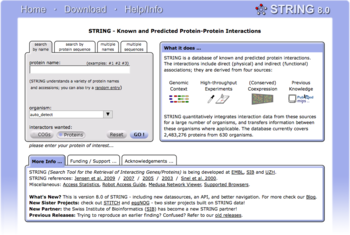
Back قاعدة بيانات حيوية Arabic Biologická databáze Czech Base de datos biológica Spanish پایگاهداده زیستشناختی Persian Biologinen tietokanta Finnish Base de données biologiques French Pangkalan data biologi Malay Banco de dados biológicos Portuguese

Biological databases are libraries of biological sciences, collected from scientific experiments, published literature, high-throughput experiment technology, and computational analysis.[citation needed] They contain information from research areas including genomics, proteomics, metabolomics, microarray gene expression, and phylogenetics.[2] Information contained in biological databases includes gene function, structure, localization (both cellular and chromosomal), clinical effects of mutations as well as similarities of biological sequences and structures.
Biological databases can be classified by the kind of data they collect (see below). Broadly, there are molecular databases (for sequences, molecules, etc.), functional databases (for physiology, enzyme activities, phenotypes, ecology etc), taxonomic databases (for species and other taxonomic ranks), images and other media, or specimens (for museum collections etc.)
Databases are important tools in assisting scientists to analyze and explain a host of biological phenomena from the structure of biomolecules and their interaction, to the whole metabolism of organisms and to understanding the evolution of species. This knowledge helps facilitate the fight against diseases, assists in the development of medications, predicting certain genetic diseases and in discovering basic relationships among species in the history of life.
- ^ Szklarczyk D; Franceschini A; Kuhn M; et al. (January 2011). "The STRING database in 2011: functional interaction networks of proteins, globally integrated and scored". Nucleic Acids Res. 39 (Database issue): D561–8. doi:10.1093/nar/gkq973. PMC 3013807. PMID 21045058.
- ^ Altman RB (March 2004). "Building successful biological databases". Brief. Bioinformatics. 5 (1): 4–5. doi:10.1093/bib/5.1.4. PMID 15153301.
© MMXXIII Rich X Search. We shall prevail. All rights reserved. Rich X Search